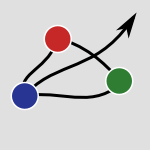93 papers:
 CHI-2015-AminiRLHI #comprehension #lens #visualisation
CHI-2015-AminiRLHI #comprehension #lens #visualisation- Understanding Data Videos: Looking at Narrative Visualization through the Cinematography Lens (FA, NHR, BL, CH, PI), pp. 1459–1468.
 DUXU-DD-2015-BellottiBL #interactive #navigation #visual notation
DUXU-DD-2015-BellottiBL #interactive #navigation #visual notation- Navigation in Interactive Visual Narrative for Children’s Appbooks (AB, PB, WDL), pp. 579–589.
 HCI-IT-2015-PolsonS #design #empirical #game studies
HCI-IT-2015-PolsonS #design #empirical #game studies- “Blind Faith”. An Experiment with Narrative Agency in Game Design (DP, VS), pp. 618–627.
 SCSM-2015-Lopez-OrnelasZ #social #social media
SCSM-2015-Lopez-OrnelasZ #social #social media- Social Media Participation: A Narrative Way to Help Urban Planners (ÉLO, NMZ), pp. 48–54.
 KDD-2015-KimS #scalability
KDD-2015-KimS #scalability- Discovering Collective Narratives of Theme Parks from Large Collections of Visitors’ Photo Streams (GK, LS), pp. 1899–1908.
 CHI-2014-AndrewsB #branch #interactive #visualisation
CHI-2014-AndrewsB #branch #interactive #visualisation- Visualizing interactive narratives: employing a branching comic to tell a story and show its readings (DA, CB), pp. 1895–1904.
 CHI-2014-Blythe #design #research
CHI-2014-Blythe #design #research- Research through design fiction: narrative in real and imaginary abstracts (MB), pp. 703–712.
 CHI-2014-PschetzYE #named
CHI-2014-PschetzYE #named- TurningPoint: narrative-driven presentation planning (LP, KY, DE), pp. 1591–1594.
 DUXU-DI-2014-Luz #evolution #experience #game studies #interface #physics
DUXU-DI-2014-Luz #evolution #experience #game studies #interface #physics- Evolution of the Physical Interfaces in Videogames as a Support to the Narrative and the Gaming Experience (ARdL), pp. 688–698.
 DUXU-DI-2014-VianaN #artificial reality #game studies #interactive
DUXU-DI-2014-VianaN #artificial reality #game studies #interactive- Immersive Interactive Narratives in Augmented Reality Games (BSV, RN), pp. 773–781.
 DUXU-TMT-2014-Bastos #design #how #realtime
DUXU-TMT-2014-Bastos #design #how #realtime- Designing Real-Time: On How Events Affect Audiovisual Narrative (MB), pp. 509–518.
 HCI-AS-2014-MoserF #branch #experience #feedback #game studies
HCI-AS-2014-MoserF #branch #experience #feedback #game studies- Narrative Control and Player Experience in Role Playing Games: Decision Points and Branching Narrative Feedback (CM, XF), pp. 622–633.
 HIMI-AS-2014-KwonJKY
HIMI-AS-2014-KwonJKY- A Knowledge Distribution Model to Support an Author in Narrative Creation (HK, SJ, HTK, WCY), pp. 511–522.
 LCT-NLE-2014-ElciD #approach #case study #education #experience #research #social #social media
LCT-NLE-2014-ElciD #approach #case study #education #experience #research #social #social media- A Narrative Research Approach: The Experiences of Social Media Support in Higher Education (AE, BÇD), pp. 36–42.
 CIKM-2014-NguyenTT #crowdsourcing #similarity #using
CIKM-2014-NguyenTT #crowdsourcing #similarity #using- Using Crowdsourcing to Investigate Perception of Narrative Similarity (DN, DT, MT), pp. 321–330.
 KR-2014-BhattST #analysis #architecture #design #experience #industrial #user interface
KR-2014-BhattST #analysis #architecture #design #experience #industrial #user interface- Computing Narratives of Cognitive User Experience for Building Design Analysis: KR for Industry Scale Computer-Aided Architecture Design (MB, CPLS, MT).
 KR-2014-DiakidoyKM0 #approach #automation #comprehension
KR-2014-DiakidoyKM0 #approach #automation #comprehension- A Psychology-Inspired Approach to Automated Narrative Text Comprehension (IAD, ACK, LM, RM).
 KR-2014-Morgenstern #concept #reasoning #representation
KR-2014-Morgenstern #concept #reasoning #representation- Representing and Reasoning about Time Travel Narratives: Foundational Concepts (LM).
 HT-2013-Kolb #adaptation #hypermedia
HT-2013-Kolb #adaptation #hypermedia- Adaptive hypertext narrative as city planning (DK), pp. 184–188.
 CHI-2013-SpauldingF #design #prototype #using
CHI-2013-SpauldingF #design #prototype #using- Design-driven narrative: using stories to prototype and build immersive design worlds (ES, HF), pp. 2843–2852.
 CHI-2013-TuchTH #experience #interactive
CHI-2013-TuchTH #experience #interactive- Analyzing users’ narratives to understand experience with interactive products (ANT, RT, KH), pp. 2079–2088.
 HCI-AS-2013-TakanoS #learning
HCI-AS-2013-TakanoS #learning- Nature Sound Ensemble Learning in Narrative-Episode Creation with Pictures (KT, SS), pp. 493–502.
 HIMI-D-2013-SumiN13a #persuasion
HIMI-D-2013-SumiN13a #persuasion- Persuasive Narrative via Digital Storytelling (KS, MN), pp. 276–283.
 HT-2012-WolffMC #approach #named
HT-2012-WolffMC #approach #named- Storyspace: a story-driven approach for creating museum narratives (AW, PM, TDC), pp. 89–98.
 SIGMOD-2012-KokkalisVZSKI #named #query
SIGMOD-2012-KokkalisVZSKI #named #query- Logos: a system for translating queries into narratives (AK, PV, AZ, AS, GK, YEI), pp. 673–676.
 CHI-2012-AndrewsBEK #branch #interactive #using
CHI-2012-AndrewsBEK #branch #interactive #using- Creating and using interactive narratives: reading and writing branching comics (DA, CB, SE, MK), pp. 1703–1712.
 CHI-2012-OlssonS #artificial reality #case study #experience #mobile
CHI-2012-OlssonS #artificial reality #case study #experience #mobile- Narratives of satisfying and unsatisfying experiences of current mobile augmented reality applications (TO, MS), pp. 2779–2788.
 CHI-2012-ParkC #named #visualisation
CHI-2012-ParkC #named #visualisation- V-model: a new innovative model to chronologically visualize narrative clinical texts (HP, JC), pp. 453–462.
 CSCW-2012-Al-AniMCJ
CSCW-2012-Al-AniMCJ- The Egyptian blogosphere: a counter-narrative of the revolution (BAA, GM, JC, JJ), pp. 17–26.
 SEKE-2012-LobatoMNAM #risk management #synthesis
SEKE-2012-LobatoMNAM #risk management #synthesis- Synthesizing Evidence on Risk Management: A Narrative Synthesis of two Mapping Studies (LLL, IdCM, PAdMSN, ESdA, SRdLM), pp. 641–646.
 MoDELS-2012-SchulzeCA #approach #modelling #uml
MoDELS-2012-SchulzeCA #approach #modelling #uml- An Approach for Synchronizing UML Models and Narrative Text in Literate Modeling (GS, JCO, JA), pp. 595–608.
 MoDELS-2012-SchulzeCA #approach #modelling #uml
MoDELS-2012-SchulzeCA #approach #modelling #uml- An Approach for Synchronizing UML Models and Narrative Text in Literate Modeling (GS, JCO, JA), pp. 595–608.
 HT-2011-ChilukuriI #algorithm
HT-2011-ChilukuriI #algorithm- An algorithm to generate engaging narratives through non-linearity (VC, BI), pp. 291–298.
 HT-2011-GoedeMNW #network #social #summary #using
HT-2011-GoedeMNW #network #social #summary #using- Succinct summaries of narrative events using social networks (BdG, MM, AN, JvW), pp. 299–304.
 HT-2011-ZsomboriFGUCKCB #automation #generative #video
HT-2011-ZsomboriFGUCKCB #automation #generative #video- Automatic generation of video narratives from shared UGC (VZ, MF, RLG, MFU, PC, IK, RC, DCAB), pp. 325–334.
 CIKM-2011-HeRSOQ #case study #generative #using
CIKM-2011-HeRSOQ #case study #generative #using- Generating links to background knowledge: a case study using narrative radiology reports (JH, MdR, MS, RCvO, YQ), pp. 1867–1876.
 KDIR-2011-NissanH #generative #information retrieval #what
KDIR-2011-NissanH #generative #information retrieval #what- Information Retrieval in the Service of Generating Narrative Explanation — What we Want from Gallura (EN, YHK), pp. 487–492.
 HT-2010-HargoodMW #approach #generative
HT-2010-HargoodMW #approach #generative- A semiotic approach for the generation of themed photo narratives (CH, DEM, MJW), pp. 19–28.
 HT-2010-TomasGJG
HT-2010-TomasGJG- A narrative-based alternative to tagging (NT, TJG, JAJ, DG), pp. 189–194.
 CHI-2010-YeeDQ #game studies #mobile
CHI-2010-YeeDQ #game studies #mobile- Investigating narrative in mobile games for seniors (SLCYY, HBLD, FKHQ), pp. 669–672.
 CSCW-2010-BirnholtzGHB #quote
CSCW-2010-BirnholtzGHB #quote- “On my way”: deceptive texting and interpersonal awareness narratives (JPB, JG, JTH, NNB), pp. 1–4.
 CIKM-2010-CataldiCS #adaptation #named #taxonomy
CIKM-2010-CataldiCS #adaptation #named #taxonomy- ANITA: a narrative interpretation of taxonomies for their adaptation to text collections (MC, KSC, MLS), pp. 1781–1784.
 SAC-2010-RubegniBPS #communication #design #multi
SAC-2010-RubegniBPS #communication #design #multi- A format to design narrative multimedia applications for cultural heritage communication (ER, NDB, PP, AS), pp. 1238–1239.
 HT-2009-Bernstein #hypermedia #on the
HT-2009-Bernstein #hypermedia #on the- On hypertext narrative (MB), pp. 5–14.
 HIMI-DIE-2009-AllenN #timeline
HIMI-DIE-2009-AllenN #timeline- Exploring History with Narrative Timelines (RBA, SN), pp. 333–338.
 OCSC-2009-Davis #comprehension
OCSC-2009-Davis #comprehension- The Whole Story: Retrieving Narratives for Cross-Cultural Understanding (AD), pp. 442–451.
 ICEIS-J-2009-SilvaS #collaboration #game studies
ICEIS-J-2009-SilvaS #collaboration #game studies- Promoting Collaboration through a Culturally Contextualized Narrative Game (MARS, JCAS), pp. 870–881.
 KDIR-2009-GoyalBM #query #using
KDIR-2009-GoyalBM #query #using- Entailment of Causal Queries in Narratives using Action Language (PG, LB, TMM), pp. 112–118.
 CHI-2008-BenfordG #interactive
CHI-2008-BenfordG #interactive- Temporal trajectories in shared interactive narratives (SB, GG), pp. 73–82.
 CHI-2008-McQuigganRL #learning
CHI-2008-McQuigganRL #learning- The effects of empathetic virtual characters on presence in narrative-centered learning environments (SWM, JPR, JCL), pp. 1511–1520.
 CHI-2008-OganAJ #learning #predict
CHI-2008-OganAJ #learning #predict- Pause, predict, and ponder: use of narrative videos to improve cultural discussion and learning (AO, VA, CJ), pp. 155–162.
 CHI-2008-StockZKREGTW #interface
CHI-2008-StockZKREGTW #interface- A co-located interface for narration to support reconciliation in a conflict: initial results from Jewish and Palestinian youth (OS, MZ, CK, CR, ZE, DGB, DT, PL(W), pp. 1583–1592.
 HT-2007-Lunn #image
HT-2007-Lunn #image- Image seeds: a communal picture-based narrative (DL), pp. 141–142.
 HT-2007-MasonT #case study #network #social
HT-2007-MasonT #case study #network #social- Tags, networks, narrative: exploring the use of social software for the study of narrative in digital contexts (BLM, ST), pp. 39–40.
 HCI-AS-2007-Yeh #3d
HCI-AS-2007-Yeh #3d- The Practice of Combining Cinematic Narrative with 3D Gameplay (CSIY), pp. 381–390.
 HCI-IDU-2007-WongK #concept #design #interface #visualisation
HCI-IDU-2007-WongK #concept #design #interface #visualisation- Quantifying the Narration Board for Visualising Final Design Concepts by Interface Designers (CYW, CWK), pp. 273–282.
 HIMI-MTT-2007-CornsML #approach #development #machine learning #optimisation #using
HIMI-MTT-2007-CornsML #approach #development #machine learning #optimisation #using- Development of an Approach for Optimizing the Accuracy of Classifying Claims Narratives Using a Machine Learning Tool (TEXTMINER[4]) (HLC, HRM, MRL), pp. 411–416.
 HIMI-MTT-2007-MarucciLC #approach #classification #fuzzy #using
HIMI-MTT-2007-MarucciLC #approach #classification #fuzzy #using- Computer Classification of Injury Narratives Using a Fuzzy Bayes Approach: Improving the Model (HRM, MRL, HLC), pp. 500–506.
 ICEIS-SAIC-2007-Silva #collaboration #using
ICEIS-SAIC-2007-Silva #collaboration #using- Using Narratives in Collaborative Writing — An Example (NDS), pp. 351–358.
 SOFTVIS-2006-BlumenkrantsSS #algorithm #visualisation
SOFTVIS-2006-BlumenkrantsSS #algorithm #visualisation- Narrative algorithm visualization (MB, HS, AS), pp. 17–26.
 ICEIS-AIDSS-2006-RokachRM #automation #concept #identification
ICEIS-AIDSS-2006-RokachRM #automation #concept #identification- Automatic Identification of Negated Concepts in Narrative Clinical Reports (LR, RR, OM), pp. 257–262.
 ICEIS-SAIC-2006-HendersonS #approach #collaboration #process
ICEIS-SAIC-2006-HendersonS #approach #collaboration #process- A Narrative Approach to Collaborative Writing — A Business Process Model (PH, NDS), pp. 166–173.
 ECOOP-2006-Cook #question
ECOOP-2006-Cook #question- Object Technology — A Grand Narrative? (SC), pp. 174–179.
 SAC-2006-FangLE #sequence #visualisation
SAC-2006-FangLE #sequence #visualisation- Visualization of unstructured text sequences of nursing narratives (SF, ML, PRE), pp. 240–244.
 HT-2005-HooperW #named
HT-2005-HooperW #named- StorySpinner: controlling narrative pace in hyperfiction (CJH, MJW), pp. 232–234.
 ICEIS-v4-2005-SilvaH #documentation #formal method
ICEIS-v4-2005-SilvaH #documentation #formal method- Narrative Support for Technical Documents: Formalising Rhetorical Structure Theory (NDS, PH), pp. 105–110.
 HT-2004-OngL #algorithm #approach #generative #interactive #search-based
HT-2004-OngL #algorithm #approach #generative #interactive #search-based- A genetic algorithm approach to interactive narrative generation (TO, JJL), pp. 181–182.
 ITiCSE-2004-Waraich #education #logic #using
ITiCSE-2004-Waraich #education #logic #using- Using narrative as a motivating device to teach binary arithmetic and logic gates (AW), pp. 97–101.
 SIGIR-2004-Sun #comprehension #representation
SIGIR-2004-Sun #comprehension #representation- Discovering and representing the contextual and narrative structure of e-books to support reading and comprehension (abstract only) (YS), p. 603.
 ITiCSE-2003-AndersenBBCM #approach #education #programming #student
ITiCSE-2003-AndersenBBCM #approach #education #programming #student- Teaching programming to liberal arts students: a narrative media approach (PBA, JB, SB, MEC, JM), pp. 109–113.
 ICEIS-v2-2003-Zarri #information management #representation #semantics #using #web
ICEIS-v2-2003-Zarri #information management #representation #semantics #using #web- Semantic Annotations and Semantic Web Using NKRL (Narrative Knowledge Representation Language) (GPZ), pp. 387–394.
 HT-2002-EmmetC #approach #design #hypermedia #persuasion #visual notation
HT-2002-EmmetC #approach #design #hypermedia #persuasion #visual notation- Graphical notations, narratives and persuasion: a Pliant Systems approach to Hypertext Tool Design (LE, GC), pp. 55–64.
 HT-2002-ZellwegerMN #hypermedia
HT-2002-ZellwegerMN #hypermedia- Reading and writing fluid Hypertext Narratives (PZ, AM, PSN), pp. 45–54.
 ICPR-v2-2002-PhungDV #analysis #education
ICPR-v2-2002-PhungDV #analysis #education- Narrative Structure Analysis with Education and Training Videos for E-Learning (DQP, CD, SV), p. 835–?.
 HT-2001-Bernstein #hypermedia #tool support
HT-2001-Bernstein #hypermedia #tool support- Card shark and thespis: exotic tools for hypertext narrative (MB), pp. 41–50.
 HT-2001-WealMMR #using
HT-2001-WealMMR #using- Building narrative structures using context based linking (MJW, DEM, DTM, DDR), pp. 37–38.
 HT-2000-Mancini #hypermedia
HT-2000-Mancini #hypermedia- From cinematographic to hypertext narrative (CM), pp. 236–237.
 KR-2000-BaralMS #problem #using
KR-2000-BaralMS #problem #using- Formulating diagnostic problem solving using an action language with narratives and sensing (CB, SAM, TCS), pp. 311–322.
 KR-2000-Reiter #source code
KR-2000-Reiter #source code- Narratives as Programs (RR), pp. 99–108.
 HT-1999-Vardi #interactive #linear #navigation
HT-1999-Vardi #interactive #linear #navigation- Navigation Scheme for Interactive Movies with Linear Narrative (GV), pp. 131–132.
 CHI-1999-PlowmanKLST #design #learning #multi
CHI-1999-PlowmanKLST #design #learning #multi- Designing Multimedia for Learning: Narrative Guidance and Narrative Construction (LP, RL, DL, MS, JT), pp. 310–317.
 HCI-EI-1999-Spinelli #multi
HCI-EI-1999-Spinelli #multi- A Multimedia System to collect, manage and search in narrative productions (GS), pp. 451–455.
 HT-1998-CrampesVR #abstraction #adaptation
HT-1998-CrampesVR #abstraction #adaptation- Adaptive Narrative Abstraction (MC, JPV, SR), pp. 97–105.
 KR-1998-Karlsson #reasoning
KR-1998-Karlsson #reasoning- Anything Can Happen: On Narratives and Hypothetical Reasoning (LK), pp. 36–47.
 KR-1998-McCarthyC
KR-1998-McCarthyC- Combining Narratives (JM, TC), pp. 48–59.
 HT-1996-SawhneyBS #named
HT-1996-SawhneyBS #named- HyperCafe: Narrative and Aesthetic Properties of Hypervideo (NS, DB, IES), pp. 1–10.
 ICDAR-v2-1995-Zarri #approach #documentation #information management #knowledge-based #representation
ICDAR-v2-1995-Zarri #approach #documentation #information management #knowledge-based #representation- The “Narrative Knowledge Representation Language”, a knowledge-based approach for representing the “meaning” of textual documents (GPZ), pp. 545–548.
 CHI-1994-CarrollAKDR94b #design #multi
CHI-1994-CarrollAKDR94b #design #multi- Raison d’Etre: capturing design history and rationale in multimedia narratives (JMC, SRA, JK, MSVD, MBR), pp. 192–197.
 CHI-1991-LaurelBDS #interface
CHI-1991-LaurelBDS #interface- Interface and narrative arts: contributions from narrative, drama, and film (BL, JB, AD, RMS), pp. 381–383.
 KR-1991-Amsterdam #reasoning
KR-1991-Amsterdam #reasoning- Temporal Reasoning and Narrative Conventions (JA), pp. 15–21.
 HT-1989-JoyceKMM #hypermedia
HT-1989-JoyceKMM #hypermedia- Hypertext, Narrative, and Consciousness (MJ, NK, JM, SM), pp. 383–384.
 KR-1989-SchubertH #information management #representation
KR-1989-SchubertH #information management #representation- An Episodic Knowledge Representation for Narrative Texts (LKS, CHH), pp. 444–458.
 CSCW-1986-Orr #process
CSCW-1986-Orr #process- Narratives at work: story telling as cooperative diagnostic activity (JEO), pp. 62–72.
 CHI-2015-AminiRLHI #comprehension #lens #visualisation
CHI-2015-AminiRLHI #comprehension #lens #visualisation DUXU-DD-2015-BellottiBL #interactive #navigation #visual notation
DUXU-DD-2015-BellottiBL #interactive #navigation #visual notation HCI-IT-2015-PolsonS #design #empirical #game studies
HCI-IT-2015-PolsonS #design #empirical #game studies SCSM-2015-Lopez-OrnelasZ #social #social media
SCSM-2015-Lopez-OrnelasZ #social #social media KDD-2015-KimS #scalability
KDD-2015-KimS #scalability CHI-2014-AndrewsB #branch #interactive #visualisation
CHI-2014-AndrewsB #branch #interactive #visualisation CHI-2014-Blythe #design #research
CHI-2014-Blythe #design #research CHI-2014-PschetzYE #named
CHI-2014-PschetzYE #named DUXU-DI-2014-Luz #evolution #experience #game studies #interface #physics
DUXU-DI-2014-Luz #evolution #experience #game studies #interface #physics DUXU-DI-2014-VianaN #artificial reality #game studies #interactive
DUXU-DI-2014-VianaN #artificial reality #game studies #interactive DUXU-TMT-2014-Bastos #design #how #realtime
DUXU-TMT-2014-Bastos #design #how #realtime HCI-AS-2014-MoserF #branch #experience #feedback #game studies
HCI-AS-2014-MoserF #branch #experience #feedback #game studies HIMI-AS-2014-KwonJKY
HIMI-AS-2014-KwonJKY LCT-NLE-2014-ElciD #approach #case study #education #experience #research #social #social media
LCT-NLE-2014-ElciD #approach #case study #education #experience #research #social #social media CIKM-2014-NguyenTT #crowdsourcing #similarity #using
CIKM-2014-NguyenTT #crowdsourcing #similarity #using KR-2014-BhattST #analysis #architecture #design #experience #industrial #user interface
KR-2014-BhattST #analysis #architecture #design #experience #industrial #user interface KR-2014-DiakidoyKM0 #approach #automation #comprehension
KR-2014-DiakidoyKM0 #approach #automation #comprehension KR-2014-Morgenstern #concept #reasoning #representation
KR-2014-Morgenstern #concept #reasoning #representation HT-2013-Kolb #adaptation #hypermedia
HT-2013-Kolb #adaptation #hypermedia CHI-2013-SpauldingF #design #prototype #using
CHI-2013-SpauldingF #design #prototype #using CHI-2013-TuchTH #experience #interactive
CHI-2013-TuchTH #experience #interactive HCI-AS-2013-TakanoS #learning
HCI-AS-2013-TakanoS #learning HIMI-D-2013-SumiN13a #persuasion
HIMI-D-2013-SumiN13a #persuasion HT-2012-WolffMC #approach #named
HT-2012-WolffMC #approach #named SIGMOD-2012-KokkalisVZSKI #named #query
SIGMOD-2012-KokkalisVZSKI #named #query CHI-2012-AndrewsBEK #branch #interactive #using
CHI-2012-AndrewsBEK #branch #interactive #using CHI-2012-OlssonS #artificial reality #case study #experience #mobile
CHI-2012-OlssonS #artificial reality #case study #experience #mobile CHI-2012-ParkC #named #visualisation
CHI-2012-ParkC #named #visualisation CSCW-2012-Al-AniMCJ
CSCW-2012-Al-AniMCJ SEKE-2012-LobatoMNAM #risk management #synthesis
SEKE-2012-LobatoMNAM #risk management #synthesis MoDELS-2012-SchulzeCA #approach #modelling #uml
MoDELS-2012-SchulzeCA #approach #modelling #uml MoDELS-2012-SchulzeCA #approach #modelling #uml
MoDELS-2012-SchulzeCA #approach #modelling #uml HT-2011-ChilukuriI #algorithm
HT-2011-ChilukuriI #algorithm HT-2011-GoedeMNW #network #social #summary #using
HT-2011-GoedeMNW #network #social #summary #using HT-2011-ZsomboriFGUCKCB #automation #generative #video
HT-2011-ZsomboriFGUCKCB #automation #generative #video CIKM-2011-HeRSOQ #case study #generative #using
CIKM-2011-HeRSOQ #case study #generative #using KDIR-2011-NissanH #generative #information retrieval #what
KDIR-2011-NissanH #generative #information retrieval #what HT-2010-HargoodMW #approach #generative
HT-2010-HargoodMW #approach #generative HT-2010-TomasGJG
HT-2010-TomasGJG CHI-2010-YeeDQ #game studies #mobile
CHI-2010-YeeDQ #game studies #mobile CSCW-2010-BirnholtzGHB #quote
CSCW-2010-BirnholtzGHB #quote CIKM-2010-CataldiCS #adaptation #named #taxonomy
CIKM-2010-CataldiCS #adaptation #named #taxonomy SAC-2010-RubegniBPS #communication #design #multi
SAC-2010-RubegniBPS #communication #design #multi HT-2009-Bernstein #hypermedia #on the
HT-2009-Bernstein #hypermedia #on the HIMI-DIE-2009-AllenN #timeline
HIMI-DIE-2009-AllenN #timeline OCSC-2009-Davis #comprehension
OCSC-2009-Davis #comprehension ICEIS-J-2009-SilvaS #collaboration #game studies
ICEIS-J-2009-SilvaS #collaboration #game studies KDIR-2009-GoyalBM #query #using
KDIR-2009-GoyalBM #query #using CHI-2008-BenfordG #interactive
CHI-2008-BenfordG #interactive CHI-2008-McQuigganRL #learning
CHI-2008-McQuigganRL #learning CHI-2008-OganAJ #learning #predict
CHI-2008-OganAJ #learning #predict CHI-2008-StockZKREGTW #interface
CHI-2008-StockZKREGTW #interface HT-2007-Lunn #image
HT-2007-Lunn #image HT-2007-MasonT #case study #network #social
HT-2007-MasonT #case study #network #social HCI-AS-2007-Yeh #3d
HCI-AS-2007-Yeh #3d HCI-IDU-2007-WongK #concept #design #interface #visualisation
HCI-IDU-2007-WongK #concept #design #interface #visualisation HIMI-MTT-2007-CornsML #approach #development #machine learning #optimisation #using
HIMI-MTT-2007-CornsML #approach #development #machine learning #optimisation #using HIMI-MTT-2007-MarucciLC #approach #classification #fuzzy #using
HIMI-MTT-2007-MarucciLC #approach #classification #fuzzy #using ICEIS-SAIC-2007-Silva #collaboration #using
ICEIS-SAIC-2007-Silva #collaboration #using SOFTVIS-2006-BlumenkrantsSS #algorithm #visualisation
SOFTVIS-2006-BlumenkrantsSS #algorithm #visualisation ICEIS-AIDSS-2006-RokachRM #automation #concept #identification
ICEIS-AIDSS-2006-RokachRM #automation #concept #identification ICEIS-SAIC-2006-HendersonS #approach #collaboration #process
ICEIS-SAIC-2006-HendersonS #approach #collaboration #process ECOOP-2006-Cook #question
ECOOP-2006-Cook #question SAC-2006-FangLE #sequence #visualisation
SAC-2006-FangLE #sequence #visualisation HT-2005-HooperW #named
HT-2005-HooperW #named ICEIS-v4-2005-SilvaH #documentation #formal method
ICEIS-v4-2005-SilvaH #documentation #formal method HT-2004-OngL #algorithm #approach #generative #interactive #search-based
HT-2004-OngL #algorithm #approach #generative #interactive #search-based ITiCSE-2004-Waraich #education #logic #using
ITiCSE-2004-Waraich #education #logic #using SIGIR-2004-Sun #comprehension #representation
SIGIR-2004-Sun #comprehension #representation ITiCSE-2003-AndersenBBCM #approach #education #programming #student
ITiCSE-2003-AndersenBBCM #approach #education #programming #student ICEIS-v2-2003-Zarri #information management #representation #semantics #using #web
ICEIS-v2-2003-Zarri #information management #representation #semantics #using #web HT-2002-EmmetC #approach #design #hypermedia #persuasion #visual notation
HT-2002-EmmetC #approach #design #hypermedia #persuasion #visual notation HT-2002-ZellwegerMN #hypermedia
HT-2002-ZellwegerMN #hypermedia ICPR-v2-2002-PhungDV #analysis #education
ICPR-v2-2002-PhungDV #analysis #education HT-2001-Bernstein #hypermedia #tool support
HT-2001-Bernstein #hypermedia #tool support HT-2001-WealMMR #using
HT-2001-WealMMR #using HT-2000-Mancini #hypermedia
HT-2000-Mancini #hypermedia KR-2000-BaralMS #problem #using
KR-2000-BaralMS #problem #using KR-2000-Reiter #source code
KR-2000-Reiter #source code HT-1999-Vardi #interactive #linear #navigation
HT-1999-Vardi #interactive #linear #navigation CHI-1999-PlowmanKLST #design #learning #multi
CHI-1999-PlowmanKLST #design #learning #multi HCI-EI-1999-Spinelli #multi
HCI-EI-1999-Spinelli #multi HT-1998-CrampesVR #abstraction #adaptation
HT-1998-CrampesVR #abstraction #adaptation KR-1998-Karlsson #reasoning
KR-1998-Karlsson #reasoning KR-1998-McCarthyC
KR-1998-McCarthyC HT-1996-SawhneyBS #named
HT-1996-SawhneyBS #named ICDAR-v2-1995-Zarri #approach #documentation #information management #knowledge-based #representation
ICDAR-v2-1995-Zarri #approach #documentation #information management #knowledge-based #representation CHI-1994-CarrollAKDR94b #design #multi
CHI-1994-CarrollAKDR94b #design #multi CHI-1991-LaurelBDS #interface
CHI-1991-LaurelBDS #interface KR-1991-Amsterdam #reasoning
KR-1991-Amsterdam #reasoning HT-1989-JoyceKMM #hypermedia
HT-1989-JoyceKMM #hypermedia KR-1989-SchubertH #information management #representation
KR-1989-SchubertH #information management #representation CSCW-1986-Orr #process
CSCW-1986-Orr #process









